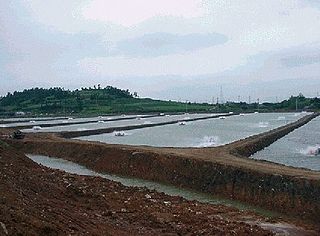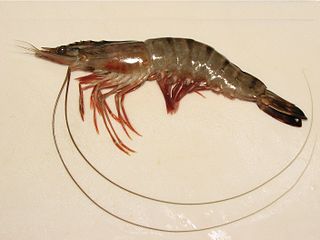Related Research Articles

Aquaculture, also known as aquafarming, is the farming of fish, crustaceans, molluscs, aquatic plants, algae, and other organisms. Aquaculture involves cultivating freshwater and saltwater populations under controlled conditions, and can be contrasted with commercial fishing, which is the harvesting of wild fish. Mariculture commonly known as marine farming refers to aquaculture practiced in marine environments and in underwater habitats.

Fish farming or pisciculture involves raising fish commercially in tanks or enclosures such as fish ponds, usually for food. It is the principal form of aquaculture, while other methods may fall under mariculture. A facility that releases juvenile fish into the wild for recreational fishing or to supplement a species' natural numbers is generally referred to as a fish hatchery. Worldwide, the most important fish species produced in fish farming are carp, tilapia, salmon, and catfish.

Selective breeding is the process by which humans use animal breeding and plant breeding to selectively develop particular phenotypic traits (characteristics) by choosing which typically animal or plant males and females will sexually reproduce and have offspring together. Domesticated animals are known as breeds, normally bred by a professional breeder, while domesticated plants are known as varieties, cultigens, cultivars, or breeds. Two purebred animals of different breeds produce a crossbreed, and crossbred plants are called hybrids. Flowers, vegetables and fruit-trees may be bred by amateurs and commercial or non-commercial professionals: major crops are usually the provenance of the professionals.

Whiteleg shrimp, also known as Pacific white shrimp or King prawn, is a variety of prawn of the eastern Pacific Ocean commonly caught or farmed for food.

The shrimp fishery is a major global industry, with more than 3.4 million tons caught per year, chiefly in Asia. Rates of bycatch are unusually high for shrimp fishing, with the capture of sea turtles being especially contentious.

Marine shrimp farming is an aquaculture business for the cultivation of marine shrimp or prawns for human consumption. Although traditional shrimp farming has been carried out in Asia for centuries, large-scale commercial shrimp farming began in the 1970s, and production grew steeply, particularly to match the market demands of the United States, Japan and Western Europe. The total global production of farmed shrimp reached more than 1.6 million tonnes in 2003, representing a value of nearly 9 billion U.S. dollars. About 75% of farmed shrimp is produced in Asia, in particular in China and Thailand. The other 25% is produced mainly in Latin America, where Brazil, Ecuador, and Mexico are the largest producers. The largest exporting nation is India.
Yellowhead disease (YHD) is a viral infection of shrimp and prawn, in particular of the giant tiger prawn, one of the two major species of farmed shrimp. The disease is highly lethal and contagious, killing shrimp quickly. Outbreaks of this disease have wiped out in a matter of days the entire populations of many shrimp farms that cultivated P. monodon, i.e. particularly Southeast Asian farms. In Thai, the disease is called hua leung.

A freshwater prawn farm is an aquaculture business designed to raise and produce freshwater prawns or shrimp for human consumption. Freshwater prawn farming shares many characteristics with, and many of the same problems as, marine shrimp farming. Unique problems are introduced by the developmental life cycle of the main species.
White spot syndrome (WSS) is a viral infection of penaeid shrimp. The disease is highly lethal and contagious, killing shrimp quickly. Outbreaks of this disease have wiped out the entire populations of many shrimp farms within a few days, in places throughout the world.
Taura syndrome (TS) is one of the more devastating diseases affecting the shrimp farming industry worldwide. It was first described in Ecuador during the summer of 1992. In March 1993, it returned as a major epidemic and was the object of extensive media coverage. Retrospective studies have suggested a case of Taura syndrome might have occurred on a shrimp farm in Colombia as early as 1990 and the virus was already present in Ecuador in mid-1991. Between 1992 and 1997, the disease spread to all major regions of the Americas where whiteleg shrimp is cultured. The economic impact of TS in the Americas during that period might have exceeded US$2 billion by some estimates.
Infectious hypodermal and hematopoietic necrosis (IHHN) is a viral disease of penaeid shrimp that causes mass mortality among the Western blue shrimp and severe deformations in the Pacific white shrimp. It occurs in Pacific farmed and wild shrimp, but not in wild shrimp on the Atlantic coast of the Americas. The shrimp-farming industry has developed several broodstocks of both P. stylirostris and P. vannamei that are resistant against IHHN infection.

Shrimp farming is an aquaculture business that exists in either a marine or freshwater environment, producing shrimp or prawns for human consumption.

Penaeus is a genus of prawns, including the giant tiger prawn, the most important species of farmed crustacean worldwide. The genus has been reorganised following a proposition of Pérez Farfante and Kensley based on morphological differences, in particular the genital characteristics of these animals, although this revision has not been universally accepted. Following the revision, many species formerly in the genus Penaeus have been reassigned to new genera in the family Penaeidae: Farfantepenaeus, Fenneropenaeus, Litopenaeus and Marsupenaeus. The following table gives an overview:

Penaeus monodon, commonly known as the giant tiger prawn,Asian tiger shrimp, black tiger shrimp, and other names, is a marine crustacean that is widely reared for food.

Fishing in India is a major industry employing 14.5 million people. India ranks second in aquaculture and third in fisheries production. Fisheries contributes to 1.07% of the Total GDP of India. According to the National Fisheries Development Board the Fisheries Industry generates an export earnings of Rs 334.41 billion. According to the Food and Agriculture Organization (FAO) of the United Nations, fish production has increased more than tenfold since 1947 and doubled between 1990 and 2010.Each year, India celebrates July 10 as the National Fish Farmers day. Koyilandy harbour in Kerala is the largest fishing harbour in Asia. It has the longest breakwater.

China, with one-fifth of the world's population, accounts for two-thirds of the world's reported aquaculture production.

South Korea occupies the southern portion of the Korean peninsula. The total land mass of the country is 98,480 km2 but usable land is only 20% of the total and thus the population is concentrated around the coast. The Korean Peninsula is surrounded by the East, West and South Seas, a coast-line that extends for about 2,413 km. Endowed with an abundance of fisheries resources, Koreans have developed a distinct seafood culture with annual per capita sea food consumption of 48.1 kg in 2005.

Eyestalk ablation is the removal of one (unilateral) or both (bilateral) eyestalks from a crustacean. It is routinely practiced on female shrimps in almost every marine shrimp maturation or reproduction facility in the world, both research and commercial. The aim of ablation under these circumstances is to stimulate the female shrimp to develop mature ovaries and spawn.

Mudnakudu Channabasappa Nandeesha was a development researcher, innovative aquaculture development worker and educator. He is recognized for making critical contributions to the rapid growth of aquaculture by applying research to key bottlenecks to fish production. In India, he conducted successful pioneering field tests of Ovaprim, an ovulating agent, under different agro-climatic conditions to help remove a critical early barrier for freshwater fish breeding. His significant scientific contributions include simplified breeding technology for cyprinids and development of feeds and feeding techniques appropriate to rural aquaculture, and helping improve and spread the practices of small scale fish farming at a time when most attention was on large scale producers. He wrote a regular and widely acclaimed column in Network of Aquaculture Centers in Asia-Pacific (NACA) Aquaculture Asia magazine on farmer innovations in aquaculture. He was described as an "ambassador for aquaculture" and was especially noted for promoting aquaculture for the disadvantaged poor households and women. Along with Michael New, in 2003 he was a founding member of the not-for-profit organisation, Aquaculture without Frontiers. While encouraging poor people to take up aquaculture, he was also a pioneer in promoting equity for women, who had been neglected in the aquaculture boom. Throughout his career, he was in the forefront of initiatives to upgrade the professionalism of fisheries and aquaculture experts, and inspired peers and students in critical new directions.
Nematopsis (Nee-mah-top-cis) is a genus gregarine Apicomplexan of the family Porosporidae. It is an aquatic parasite of crustaceans with a molluscan intermediate host. Nematopsis has been distinguished from the similar genus Porospora by its resistant and encapsulated oocyst. Little molecular biology has been performed on the members of the Nemaptosis and species are described based on molluscan and crustacean hosts as well as oocyst structure. A total of 38 species have been described and are found all over the world.
References
- 1 2 Melba G. Bondad-Reantaso; S. E. McGladdery; I. East; R. P. Subasinghe, eds. (2001). "Asia Diagnostic Guide to Aquatic Animal Diseases" (PDF). FAO Fisheries Technical Paper 402/2, NACA/FAO 2001. p. 207, "Chapter 4". ISBN 92-5-104620-4.
- 1 2 Melba G. Bondad-Reantaso; S. E. McGladdery; I. East; R. P. Subasinghe (eds.). "Chapter 4". Asia Diagnostic Guide to Aquatic Animal Diseases (PDF). FAO Fisheries Technical Paper 402/2, NACA/FAO 2001. ISBN 92-5-104620-4.
- ↑ "Access online: Manual of Diagnostic Tests for Aquatic Animals - OIE - World Organisation for Animal Health". www.oie.int. Retrieved 2017-09-07.
- ↑ S. M. Bower (1996). "Synopsis of Infectious Diseases and Parasites of Commercially Exploited Shellfish: Necrotizing Hepatopancreatitis of Penaeid Shrimp".
- ↑ Donald V. Lightner, ed. (1996). A Handbook of Shrimp Pathology and Diagnostic Procedures for Disease of Cultured Penaeid Shrimp. Baton Rouge: World Aquaculture Society. ISBN 0-9624529-9-8.
| This veterinary medicine –related article is a stub. You can help Wikipedia by expanding it. |